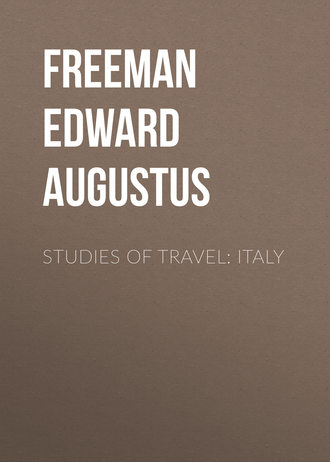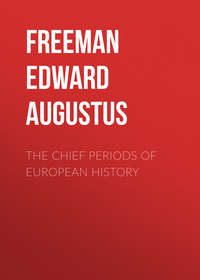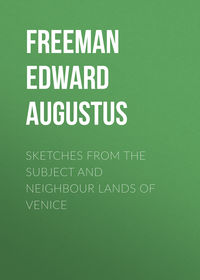 полная версия
полная версияStudies of Travel: Italy
Something of this kind is likely to be the destiny, at some point at least, of those who wish to carry out the full programme of the right wing of the Latin host of Regillus:
Aricia, Cora, Norba,Velitræ, with the mightOf Setia and of Tusculum.Tusculum they will, perhaps, have made the object of a separate pilgrimage; Aricia belongs to the following of Jupiter and the Alban mount; "Setia's purple vineyards" it may be hard to take into the line of march; but, with a slight change of order, "Velitræ, Cora, Norba," with the later Ninfa thrown in as a substitute for neglected Setia, will form an admirable group, a day's journey, which those who have made it will perhaps, at the end of a day or two, feel sorry that they have not cut into two. Velitræ – hardly changed in the modern Velletri – has itself but little to show beyond one of the very noblest bell-towers of the second Italian period, where the pointed arch creeps in, a visitor which in Italy is better away, but which at least keeps out the vagaries of a yet later time. The lie of the town is good; it stands well on its hill, of no great elevation among its brighter neighbours. Besides the bell-tower, it has little to show in the ecclesiastical line, save only the eccentricity of having its cathedral church placed as if we were in Wales instead of in Italy, at the bottom of the city instead of at the top. One or two ancient houses and modern palaces may claim some attention, but Velletri, truly barren in Roman remains, cannot be said to be fruitful in those of mediæval times. The chief value of the town is as a starting-point – we can hardly call it centre – for Cora, Norba, and several other of its ancient fellows. The view from Velletri is beyond words. We look over the fertile plain, dying away to the right into the Pomptine marshes, and fenced in by the mighty limestone bulwark of the Volscian mountains. To the right of all the height of Anxur's temple looms in the distance; Circeii, with its following of islands, rises nearer and more plainly, almost itself like a great island, reminding the visitor from the West of England of Brean Down and the Holms in the Severn Sea. But the mountains draw the eyes towards them by something more than their bright masses, something more than a light and shade upon their sides. Several of their strong points are crowned with castles and whole towns; and one point so crowned stands out as the centre of all. We see one spur of the mountain, far lower than the heights beyond it, crowned by a little city coming some way down its sides, with a tall tower rising well from the midst when the sunlight catches it. There stands one of the chief objects for which Velletri is the starting-point; there we have to look for —
… the gigantic watch-towers,No work of earthly men,Whence Cora's sentinel's o'erlookThe never-ending fen.Watch-towers, perhaps, in the strictest sense, we do not see, and we shall hardly find them when we come nearer; but Cora, Cori, still keeps the mightiest of walls, which it was no wonder that men looked on as too mighty to be the work of such mortals – in Homer's phrase – as we now are, and looked on them as reared by no hands weaker than those of the forgers of Jove's own thunderbolts. With Cori we enter on the examination of a long series of towns, whose main feature is their primæval walls, and among these Cori has the merit of showing us the walls that are the most primæval of all. None of its fellows can show such blocks as the mysterious engineers, whose work men love to call Cyclopean, piled together in the lower town of Cori, just outside what is now the gate of Ninfa. Blocks indeed of equal size we may see elsewhere, but surely none of equal rudeness. They are heaped together as they were hewn or torn away from their place in the natural rock; huge limestone blocks of every size and shape, with the spaces between them filled up with similar stones of their own kind. But the whole range of the wall of Cori is not of this primitive sort. The curious in such matters distinguish five epochs: Cyclopean, Latin, Old Roman, Roman of Sulla's day, and – the leap is a great one – mediæval walls of the time of King Ladislaus; we hardly venture to give an Angevin king of the hither Sicily the full Slavonic shape which marks him as sprung from the other side of Hadria. The stones of the first four – we have already spoken of the first of all – are all polygonal, of distinguishing degrees of regularity of work and degrees of size. The rudest wall, as far as we saw, of all is to be found quite at the bottom; the others may be seen side by side in the great walls of the arx which soar high above all, and which shelter the chief ornament of Cori in quite another department.
According to the nearly invariable rule, the arx of Cora contained a temple, and the temple, as so often happens, has been turned into a church. But the change has been less destructive to Cori than in many other places. The house of St. Peter has been built without damaging the portico of the house of Hercules – the old Latin Herculus was hopelessly confused with the Hêraklês of Greek legend – and still keeps the columns of his portico, both on its front and its sides; keeps his entablature, his pediment, the gate-way of his cella, the inscription which records the work of the local duumvirs, Manlius and Turpilius. But what shall we say to the columns themselves? They profess to be Doric, even to be Greek Doric; but they have bases; they stand as wide apart as Etruscan tradition planted the columns of the Capitoline Jupiter; the shafts themselves, instead of being as massive as Pæstum, are slenderer than Nemea. But sin against rule as it may, the upper temple at Cori is still undoubtedly pretty, to say the least, and it is really all the more interesting because of its sin against rule. Far finer in themselves are the Corinthian columns – such as are left – of the temple of the Greek Twin Brethren lower down the hill; but we can see good Corinthian columns in a great many places; the peculiarities of the Hercules temple are special to Cori. Do they not speak of the Hellenizing mind of the great dictator who made Cora rise again after it had suffered deeply at the hands of his Marian enemies? Stern restorer of what he deemed Rome's ancient ways, but votary and favourite of Hellenic gods, the taste of Sulla might well lead him to some such forms as we see in the object, yet prominent from many points of view, that crowns the height of the citadel of Cora.
But we have not gone through the full tale of the antiquities of this strange little mountain-city. Outside the Ninfa gate, spanning at a vast height the deep gorge which on that side forms the foss of Cori, rises a bridge, of days which we call ancient, but which we are tempted to call modern so near to the Cyclopean wall. Not a few fragments of columns may be marked here and there in the streets. We light too on inscriptions. Besides the duumvirs– one might call them the bailiffs – of the Roman Municipium, whose names are carved on the frieze of Hercules, another commemorates two Praitors; surely these, with their archaic spelling, are the abiding magistrates of the Latin Commonwealth – as Cicero's Milo was dictator of Lanuvium – dependent on Rome, but not fully incorporated in her substance. Then, besides the chief temple, other Pagan buildings and objects have been turned to Christian uses. In the church where St. Peter has supplanted Hercules, an altar, if altar it be, bearing rams with horns and the Gorgon's head, has been hollowed out to make a baptismal font. The church of St. Oliva bears a dedication dating only from the sixteenth century; but it is a lovely cloister of that better kind of Renaissance which was in truth only a falling back on Romanesque. In the church are memorials of earlier times, classical columns used again, fitted some of them with capitals of the very rudest Romanesque, whose fellows may be found in Worcester and at Hildesheim. Altogether Cori is emphatically a place for a visit. But a word of warning must be given. Cori and Norba cannot be combined so as to see both worthily in a single day. Let the traveller either make two distinct outings from Velletri, or let him take his chance of sleeping at Cori; it may not be a worse chance than sleeping at Frosinone, where sleep may be had. Then let him rise up early in the morning and saddle his ass, or, if able-bodied, let him rather make his way on his own feet along the mountain-path to Norba.
Norba
We will suppose that, the mutual curiosity of natives and strangers having been fully gratified at Cori, the strangers have set out on their way, on mule-back or otherwise. The mountain-track up and down, skirting the lower heights of the Volscian range, opens noble views of the higher mountains inland, of the wide flat below, and of the sea beyond. But these views are perhaps, on the whole, better enjoyed when the traveller has found a firm foothold within "Norba's ancient wall" than while he has personal experience how
The patient ass, up flinty paths,Plods with his weary load.Still worse indeed is it when the flinty paths have to be plodded down, and when the weary load needs all his theoretical philosophy to persuade him how thoroughly safe he really is, while the weakness of the flesh surrounds the descent with terrors which he knows to be unreal. At last the ancient wall rises immediately before him; the hill-side, a small height straight above the path, is climbed on his own feet, and he can presently contemplate at his ease both the wall itself and the prospect which it commands. The last part of the ass-track has become so like a lane anywhere else that we are amazed when we reach the other side of the immediate height of Norba, and find how far below lies the plain from which the almost perpendicular cliffs spring to bear up the forsaken city. For at Norba the curiosity will be almost wholly on the side of the stranger; in cannot be returned in kind, as at Cori; a lone shepherd or two may come to look at him; he cannot bring together the least approach to a triumphal procession. For within the wall all is, we cannot say desolate or forsaken, for the crops are there, full and green – "segetes, ubi Norba fuit" – but the ancient circuit is at least empty of all dwelling-places of man. We would fain believe that the space has stood as empty as it now does ever since the people of Norba – less wise, as the event showed, than their neighbours of Cora – embraced the cause of Marius with such desperate zeal that they slew themselves and burned their houses rather than let either themselves or their goods fall into the hands of Sulla. This inference might possibly be rash; for the ancient wall fences in at least one ruin which may be later than the days of the fortunate dictator. But it is clear that Norba, if it recovered from this great single blow, gradually dwindled away, to the profit, first of Norma by its side, which still abides, and of Ninfa, at its foot, which has perished only less utterly than Norba itself.
Cori and Norba are alike cities set on hills, and neither of them has any fear of being hid. But they are set on hills in different senses. Cori occupies the upper part of the sloping hill, and the houses spread down the slope. Norba occupies a large table-land on the edge of the mountains, and its outer wall is carried along the upper rim of a steep and lofty cliff. No dwellings could ever have spread themselves downwards on the side which looks toward the marshes and the sea. But we should hardly have said the outer wall; for the height was so carefully fortified that outlying defences were placed at various points on the side of the cliff wherever the primitive engineers deemed such defences needful. Within the circuit, again, the arx rose on several terraces; its highest point – crowned, we may believe, as usual, by a temple – must have formed a proud object indeed from the vast extent of land and sea which it looks down upon. No other of its ancient neighbours looks down so immediately on the great Pomptine flat as Norba does, as none looks down from so great a height. Cori rather occupies a hill thrown out in front of the mountain; Norba sits on the edge of the mountain itself, though of course at a much lower elevation than the huge masses further inland. The towers and temples of the city must have had a wonderful effect from the lands below; as it is, there is nothing to mark the place but the line of wall itself, which does not always stand out in a very marked way from the cliff. It is then perhaps in some sort well that the later Norma has taken the place of Norba. On the hill of Norba we see that Norma and Norba by no means join one another; there is a gap between them which, while we are on the mountain, might pass for a valley. But as we look from below, the winding outline of the hills puts this gap out of sight, and Norma and Norba become in appearance one whole. Norma looks like a continuation of Norba; it might pass for its still inhabited part, perhaps, as at Syracuse and Girgenti, for the elder stronghold within which the city had again shrunk up. From the points where the eye can take in ruined Ninfa at the foot of the cliff, and the further town of Sermoneta crowning a hill-top far lower than the height of Norba, the whole grouping is wonderful. The view from Norba itself takes in points with which we have become familiar since we first gazed on them from the height of the Latian Jupiter. But we see them in new groupings and new proportions; the islands, prisons for dangerous or discreditable members of the Imperial house, stand out in special prominence in front of the Circæan height – a height so nearly cut off from the mainland that it seems like the greatest of the island group. Nowhere do we better understand what men looked on as a great and strong city in days when they had not yet learned that an element of truer might lurked in what, judged by the standard of Norba, would seem a mere group of molehills by the yellow Tiber.
As the whole city lay on the top of the hill, the space taken in by the walls is necessarily greater than in those towns where the hill stands distinct, the arx alone crowns the top, and where the town walls are placed lower down. The nature of the construction adapts itself to the needs of the different parts of the circuit. The mass of the wall is of polygonal stones, rude, but far less rude than the rudest at Cori. Without being actually laid in regular order, they have a certain tendency to fall into courses as it were of themselves, and it is not always easy to tell how far the roughness of the stone has been from the beginning, and how far it is due to the action of the weather on stones cut perhaps somewhat less carefully than the finer stones at Cori. But the Norban builders could, when it was worth their while, do something more than this. They could, when they had to make a corner, put together squared stones cut with a good deal of exactness, and when it was convenient that a corner should be rounded off, they could do that too with equal skill. This last was done at the greatest gateway looking towards Norma. Here there is no sign of either lintel, arch, or attempt at arch, to span the opening; it would almost seem that the gate itself was simply placed across the opening with nothing over it, much as at Tusculum the gate was hung between two pieces of native rock. That the arch was not known to the first builders of Norba, but that they had reached the stage in which men began as it were to stretch forth their hands towards that great invention, is shown by a ruined building – one of the few things within the wall of Norba which can be called even a ruined building – a little way beyond the arx. Here we have a distinct attempt at a vault for the roof; but it is not the apparent cupola of Mykênê and New Grange, nor the apparent barrel-vault of Tusculum. The building is oblong, and the attempted arches rise on both sides, from the small ones as well as from the longer. The ruined state of the building, whatever it was, most unluckily hinders us from seeing how the four vaults, so to call them, were made to meet in the middle. It must have been a strange problem in construction. Hard by is the other building at which we have already hinted as being of later date. It has real arches and masonry, like that which at Cori is attributed to Sulla's time. But it may as well come before the overthrow of Norba in his day as after it.
From primæval and forsaken Norba we go down the hill-side, learning as we go how high Norba stands, to hardly less forsaken, though only mediæval, Ninfa. Ninfa, unlike Norba, has a few inhabitants; there is a house and a mill, if not within the fortified enclosure, at least just outside it, and, if the enclosure itself contains no actual dwelling-places of man, it contains abundance of buildings which have once been so. One can hardly fancy a greater contrast than that which strikes us between the stern primæval wall of Norba, fencing in the thick-standing corn, and the wall of Ninfa, with its towers, its varied and picturesque outline, fencing in a crowd of houses, churches, and buildings of every kind, the oldest of which could not have arisen till a thousand years after Norba became desolate. All are now forsaken, roofless, shattered, forming one of the most singular gatherings of ruins to be seen anywhere, the mummy, as it has been well called, of a dead town. Ninfa was once a place of some consequence, which played its part in local history; perhaps the most notable event suggested by its name is that here Alexander III., a Pope who had so much to do with our own history, was consecrated after his famous disputed election. But its position in the deadly flat, close by a stream, led to its ruin; the malaria was too much for it, and Ninfa ceased to be reckoned among the cities of articulate-speaking men. Some freak might restore the greatness of Norba; for there is nothing to hinder men living there if the fancy took them; they cannot live at Ninfa without greater changes than a Marius or a Sulla can work. There is something specially striking in a town, whose remains are so extensive, standing so utterly desolate. There is something Irish in the look of things at Ninfa, as indeed there is in the look of a good many of the ruined mediæval sites which often meet us in this region. It is not merely the fact of their being ruined, though there is something Irish in that; the tall, slender towers, of which there are many both at Ninfa and elsewhere, have a real likeness to many buildings in Ireland. But, though the general look of Ninfa is singularly striking, there is less to be learned from the particular buildings than might have been looked for. They are spread over several centuries, some of the houses reaching even into Renaissance times. The church of most pretension lies without the walls; several within them keep their apses and the paintings on them, but little more. The whole is a wilderness of ruins, strange, impressive, but hardly venerable. As the ruin of a town, the wreck of many buildings crowded close together, fallen Ninfa has little of the solemnity of our own ruined castles and abbeys. As for the elements of wonder and mystery, they dwell in this region on the hill-top, among the mighty masses of stone which the men of an unrecorded age piled together to make Norba.
Segni
The visitor to Segni will find difficulties in studying the history on the spot second only to those which he finds at Norba. It is quite certain that he will find no books at Norba, save such as he may take with him, which are not likely to be many. It is possible that there may be books at Segni; there may lurk in some odd corner either a hidden scholar with his treasured library, or a bookseller of that class, sometimes to be found in old-fashioned places, who dislikes nothing so much as parting with his books. But, if such there be, they do not force themselves on the eye on one's entrance into Segni. A natural and important question is sure to present itself, and – without wings to fly at once to the libraries of Rome – there is no immediate means of answering it. Is the name of Signia – now by a very slight change Segni– to be found in any of the lists of the Thirty Cities of Latium? The lists are many, and the traveller is not likely to carry them all in his head. He may perhaps be able to repeat the lines in which Macaulay draws the picture of many of them; and, if so, every step that he takes among the Latin cities will make him more fully admire the fitness and force of the points and epithets picked out in each case. But at Segni the Lay of Regillus fails him; he has his quotations for Cora and Norba; he has no quotations for Signia. Still Macaulay's verses are not a full or formal list of the cities; while, if he argues that Signia lies too much in the heart of the Volscian and Hernican land to have belonged to the Latin name, he is met by the fact that "Ferentinum of the rock," yet further on, has its place in them alongside of "Gabia of the pool." He turns to his guide-book – and the guide-book of Gsell-fels, though it sometimes leaves things out, is almost always to be trusted for what it puts in; he there finds only the entry of the alleged Roman colony of the days of the Tarquins, with the remark that the existing walls seem to point to an earlier origin. And again a thought may occur to him, if not at Segni itself, yet in the later course of the journey of which Segni forms a part – Were the people of ancient Signia specially skilful in the making of mosaic pavements? There is a kind of work called opus Signinum, a pattern of black spots on a white ground, of which there is a good deal at Pompeii, and of which the visitor to Segni will most likely see an example a few days later at Anagni. The question is hardly so exciting as the question as to the position of Signia in the days of the Latin League. But it is one which may suggest itself, and it is one which it will be hard to answer with only the resources which are to be had at Segni itself. The visitor to Segni is thus likely to find himself a little uncomfortable as to more than one point in the history of the place where he stands. And he will feel most uncomfortable of all as to the great point of all with regard to its earliest history. Still, he may for the moment comfort himself by thinking that there are those who might be unkind enough to hint that he would still be equally uncertain if he had a hundred quotations on the tip of his tongue, or if he were in a library with thousands of volumes to turn to.
But whether Signia was ever a Thirty-city or not – we may be allowed to follow the local usage of Canterbury, which speaks of "a Six-preacher" – there is no doubt as to its geographical position; there is no doubt as to the grandeur of its remains. In starting from Velletri, with Algidus and its holm-oaks and its memories of Æquian encampments on our left hand, on the right we turn the corner of the Volscian mountains, and the railway carries us along the valley between them and their Hernican rivals. We reach the station of Segni; we mark more than one town perched on the opposite heights; we have close by us, in the low ground – reminding us of Ninfa on a smaller scale – the walls of a forsaken fortress, with a shattered tower of wonderful height and slenderness; but the walls of Signia still keep themselves hidden among the mountains. It is not from the side of Velletri, but, as we afterwards learn, from the side of Anagni, that Segni on its mountain height, and its satellite of Gavignano, perched on a smaller detached hill in front, form striking features in the landscape.
Segni belongs to the same class of hill-fortress as Norba, not the same class as Cori. It occupies, not the top of a conical hill, but a table-land, if we may apply that name to so narrow a space, on the mountain itself. The distinction is well marked by comparing it with Gavignano just below, which is one of the chief objects in the immediate view from the height of Segni. The difference is just the same as the difference between Norba and Sermoneta, though Gavignano has more the air of being an outpost of Segni than Sermoneta has of being an outpost of Norba. The hill-top which Segni crowns is long and narrow, at some points very narrow indeed, so as to give to the space within the walls nearly the shape of a figure of eight. The space within is neither wholly forsaken, as at Norba, nor all crowded with dwellings, as at Cori. The modern town has withdrawn into one quarter of the old enclosure; but it has not, as in so many other cases, withdrawn into the ancient citadel. The site of the arx of Signia, rising but little above the general level of the hill-top, but placed well so as to command what we may call the isthmus between the two parts of the town, forms no part of the dwelling-place of the modern Signians; but under the name of Passegiata it does form part of their pleasure-ground. The modern town has retreated into the other loop of the figure of eight, that which lies furthest from the traveller as he draws near from Velletri, but to which the course of the road will necessarily take him first. He may enter by a gateway of Roman date, and if he so does his eye will soon be struck by the great number of graceful fragments of mediæval work to be found within the narrow streets of Segni. The town has most likely been for ages too poor to follow the example of its richer neighbours in replacing beauty by ugliness. But he will do better to keep for a while from entering the inhabited part of the town. Let him first make the circuit of the ancient walls. And he can hardly doubt whether to turn to the right hand or to the left. The claims of the left are in this case overwhelming. Long before he has reached the town, he must have seen far away on the hill the most precious of the remains of Signia, the gateway which stands, forsaken but still untouched, beckoning him, as it were, to make his way first of all to the most instructive thing which the primæval city has to show him.







